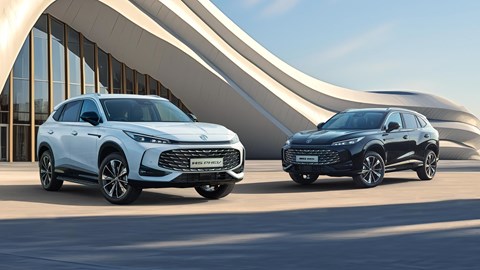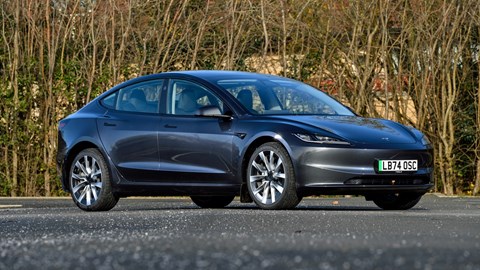► How company car tax works
► Benefit-in-kind (BIK) tax explained
► Why CO2 emissions will cost you more
Company cars, whether sold through fleets or businesses, now account for a far greater share of new car sales than those to private individuals, and this percentage has only kept increasing in recent years.
As a result, it makes it an important sector that car manufacturers target, especially for electric cars, which are considerably cheaper to run as company cars. Though a company car is often a perk of a job, it’s by no means free as there’s a tax implication on it, which can prove significant depending on the car.
Let’s look at how company car tax is calculated, how much it costs and any changes on the horizon. All of this will help you if you’re looking for a company car andl help you to make an informed financial decision.
What is benefit-in-kind (BIK) tax?
A company car is seen as a benefit-in-kind (BIK) by HMRC since it’s usually supplied as a perk in addition to an employee’s salary. This means that if you use a company car, you are required to pay annual tax on it, in the same way that you would if your employer gave you free health insurance.
BIK tax rates change most years and the planned rates for future years are known well in advance. In the UK, company car tax is decided by a vehicle’s emissions, its value and your personal income tax rate.

Every car has a BIK tax banding percentage, which is based on the CO2 emissions it produces. As most company cars are kept for several years, it’s worth looking at future years. For example, all plug-in hybrids will have a steep increase in company car tax in the 2028/29 financial year. The bandings are as follows.
| CO2 (g/km) | Electric range (miles) | 2024/25 (%) | 2025/26 (%) | 2026/27 (%) | 2027/28 (%) | 2028/29 (%) | 2029/30 (%) |
| 0 | N/A | 2 | 3 | 4 | 5 | 7 | 9 |
| 1-50 | > 130 | 2 | 3 | 4 | 5 | 18 | 19 |
| 1-50 | 70 to 129 | 5 | 6 | 7 | 8 | 18 | 19 |
| 1-50 | 40 to 69 | 8 | 9 | 10 | 11 | 18 | 19 |
| 1-50 | 30 to 39 | 12 | 13 | 14 | 15 | 18 | 19 |
| 1-50 | < 30 | 14 | 15 | 16 | 17 | 19 | 19 |
| 51 to 54 | | 15 | 16 | 17 | 18 | 19 | 20 |
| 55 to 59 | | 16 | 17 | 18 | 19 | 20 | 21 |
| 60 to 64 | | 17 | 18 | 19 | 20 | 21 | 22 |
| 65 to 69 | | 18 | 19 | 20 | 21 | 22 | 23 |
| 70 to 74 | | 19 | 20 | 21 | 21 | 22 | 23 |
| 75 to 79 | | 20 | 21 | 21 | 21 | 22 | 23 |
| 80 to 84 | | 21 | 22 | 22 | 22 | 23 | 24 |
| 85 to 89 | | 22 | 23 | 23 | 23 | 24 | 25 |
| 90 to 94 | | 23 | 24 | 24 | 24 | 25 | 26 |
| 95 to 99 | | 24 | 25 | 25 | 25 | 26 | 27 |
| 100 to 104 | | 25 | 26 | 26 | 26 | 27 | 28 |
| 105 to 109 | | 26 | 27 | 27 | 27 | 28 | 29 |
| 110 to 114 | | 27 | 28 | 28 | 28 | 29 | 30 |
| 115 to 119 | | 28 | 29 | 29 | 29 | 30 | 31 |
| 120 to 124 | | 29 | 30 | 30 | 30 | 31 | 32 |
| 125 to 129 | | 30 | 31 | 31 | 31 | 32 | 33 |
| 130 to 134 | | 31 | 32 | 32 | 32 | 33 | 34 |
| 135 to 139 | | 32 | 33 | 33 | 33 | 34 | 35 |
| 140 to 144 | | 33 | 34 | 34 | 34 | 35 | 36 |
| 145 to 149 | | 34 | 35 | 35 | 35 | 36 | 37 |
| 150 to 154 | | 35 | 36 | 36 | 36 | 37 | 38 |
| 155 to 159 | | 36 | 37 | 37 | 37 | 38 | 39 |
| 160+ | | 37 | 37 | 37 | 37 | 38 | 39 |
What is a P11D value?
A P11D value is used to calculate company car tax, and is an important number for this reason.
The P11D value is the total value of a car when it was new, including the list price, optional extras (including paint colours and different wheels), VAT and delivery charges from the manufacturer. However, it does not include the DVLA first registration fee or annual road tax. It therefore tends to look slightly different to the actual on-the-road price quoted by dealers and by CAR.
How is company car tax calculated?
The main factor in working out how much company car tax you’ll pay depends on a vehicle’s CO2 emissions. The cleaner it is, the less you’ll pay, which is why it generally favours electric vehicles and plug-in hybrid models, although there is some uncertainty surrounding PHEVs, as we’ll explore in a later section. If you’re looking at a plug-in hybrid as a company car, look at its quoted electric range as this will also influence what you’ll pay.

To calculate the company car (BIK) tax, multiply the P11D value by the BIK percentage figure, and then multiply that figure by your personal tax band (20 or 40 per cent). This figure will give you the annual amount of BIK you need to pay, so divide it by 12 to see the monthly outgoing.
Here are two examples of company car tax for the 2025/26 financial year.
Car: Tesla Model 3 RWD
P11D value: £39,935
CO2 emissions: 0g/km
Company car tax band: 3%
Taxable benefit-in-kind: £1,198.05 (3% of the P11D list price)
Driver BIK tax bill: £239.61 per annum (lower rate taxpayer at 20% tax), £479.22 (higher rate taxpayer at 40% tax)
Car: Volkswagen Golf Style 1.5 eTSI
P11D value: £30,400
CO2 emissions: 121g/km
Company car tax band: 30%
Taxable benefit-in-kind: £9,120 (30% of the P11D list price)
Driver BIK tax bill: £1,824 per annum (lower rate taxpayer at 20% tax), £3,648 (higher rate taxpayer at 40% tax)
If you look at the difference between what you’ll pay on an electric car and a run-of-the-mill petrol hatchback like a Volkswagen Golf, you’ll get an idea of why electric cars are proving so popular to company car drivers because of the cost savings on offer.
Big changes coming for plug-in hybrid cars and BIK
Alongside electric cars, plug-in hybrid vehicles (PHEVs) have proven popular with company car drivers owing to their cheaper BIK as a result of their lower claimed CO2 emissions. However, many PHEVs now face a potentially steep increase in BIK rates because of a change in how emissions tests are carried out on them.
Known as Euro 6e-bis, the revised emissions test applies to all newly launched PHEVs from January 1, 2025, and will apply to all new models by the end of 2025. The more rigorous test now involves measuring a vehicle’s emissions for a greater distance when a PHEV’s battery is empty, and therefore when they’re least efficient.

To illustrate the difference the changes will make, the International Council on Clean Transport (ICCT) analysed the effect on a BMW X1 plug-in hybrid. Under the current testing model, this car has an official CO2 emission value of around 45g/km, but under the new tests, the emissions value will more than double to 96g/km. This will see the BIK rate increase from 8% to 24%, and will mean a significant increase in what you’ll pay in company car tax
Drivers who already have a PHEV as a company car will not be affected, but those ordering a new car could see a steep potential steep increase if the car is retested between the point of ordering and delivery. Fewer are likely to choose PHEVs as company cars as a result of these measures, either.